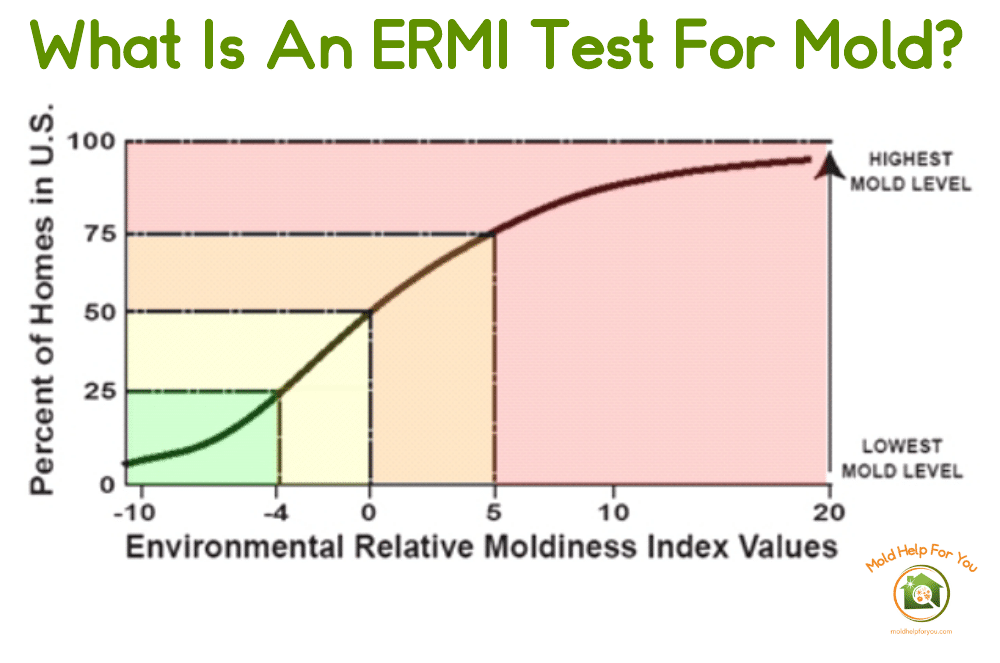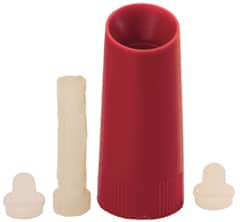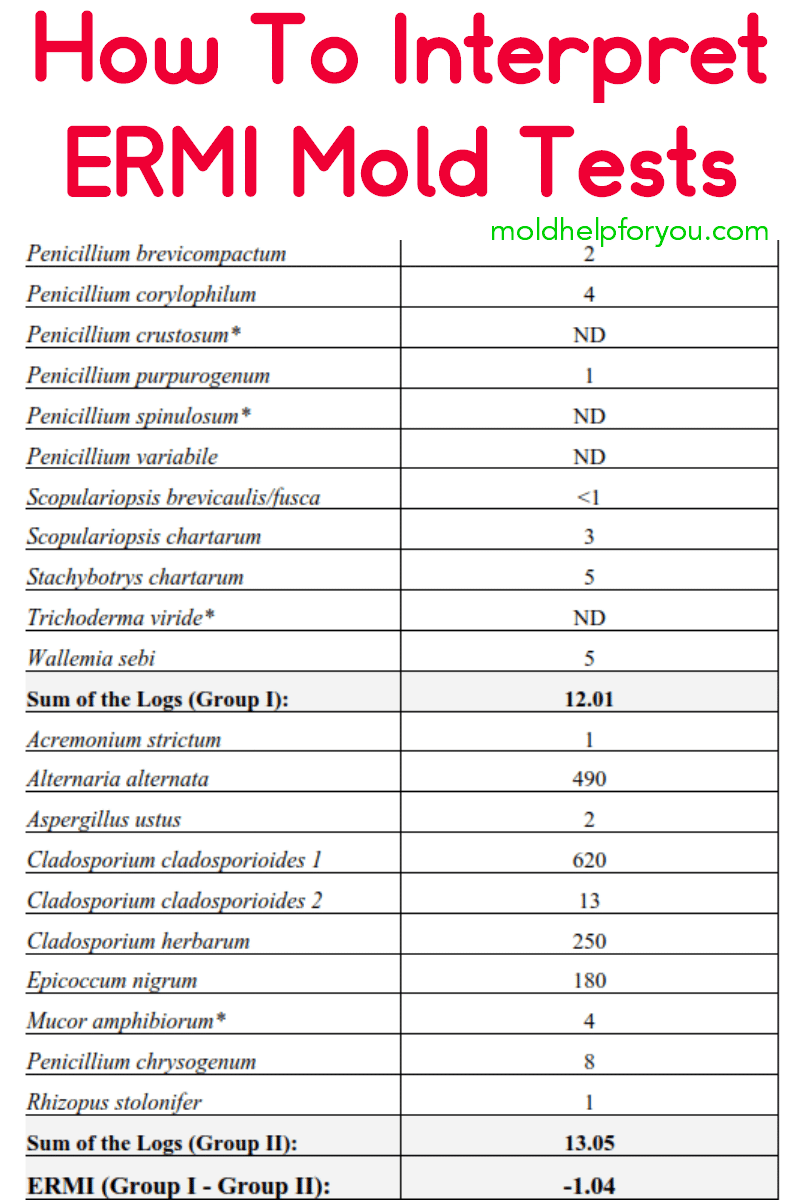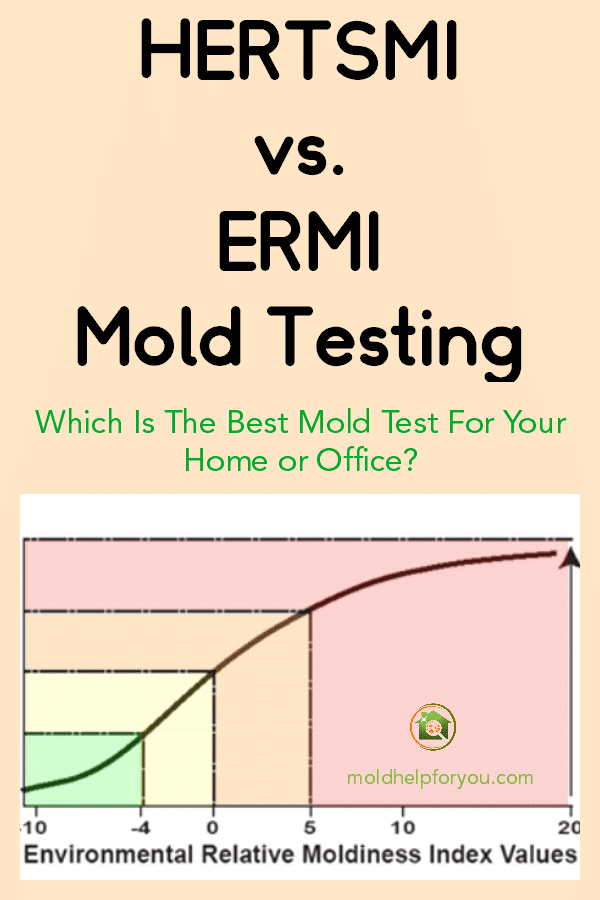What Is An ERMI Mold Test?
This post may contain affiliate links. Read our full disclosure.
ERMI stands for Environmental Relative Moldiness Index.
An ERMI mold test is a standardized objective test used to quantify the indoor mold burden on a building. It is the mold test to start with if you are unsure if you have mold or have had a leak and want to confirm or dispute the presence of mold in a particular room.
ERMI is a DNA based method of testing that will identify and quantify molds. The sample is analyzed using mold-specific quantitative polymerase chain reaction (MSQPCR). ERMI uses the analysis of settled dust in homes and buildings to determine the concentrations of the DNA of the different species of molds.
The ERMI test is representative of mold levels over time rather than a “snap shot” of the current state of mold spores in the home. It has many uses, including helping to determine if a home has suffered water damage in the past that had resulted in mold.
According to the EPA, “The ERMI should be used only for research. The ERMI has not been validated for routine pubic use in homes, schools, or other buildings.” There is truth in this as you would not want to use an ERMI as a clearance test after mold remediation has been performed.

How Was ERMI Developed?
The Environmental Protection Authority (EPA) developed the ERMI to provide a straightforward, objective, sensitive and standardized way to assess mold and indoor air quality investigations. It is based on widely published data from EPA researchers and the 2006 HUD American Healthy Home Survey.
In initial studies by the EPA, the concentrations of different mold species in “moldy homes” (homes with visible mold growth or a history of water damage) and “reference homes” (homes with no visible mold) were compared. Based on those results, mold species were selected and grouped into those with higher concentrations in moldy homes (group 1) and those with lower concentrations (group 2).
In order to most effectively use this tool, the ERMI obtained needs to be compared to a national database. Indices were determined using this method for 1,096 homes across the U.S. as part of the 2006 HUD American Healthy Home Survey. Individual indices ranked from lowest to highest were used to create a national Relative Moldiness Index (RMI) Scale.
What Types Of Mold Does The ERMI Mold Test Check For?
While there are oh so many types of mold, the ERMI tests for 36 species that are divided into 26 species/clusters of molds associated with water damaged buildings (Group 1) and 10 common species/clusters not associated with water damaged buildings and more likely to be found outdoors (Group 2). The molds the ERMI identifies are:
| Group 1: Water Damage Molds | Group 2: Common Indoor Molds |
| Aspergillus flavus/oryzae | Acremonium strictum |
| Aspergillus fumigatus | Alternaria alternata |
| Aspergillus niger | Aspergillus ustus |
| Aspergillus ochraceus | Cladosporium cladosporioides 1 |
| Aspergillus penicillioides | Cladosporium cladosporioides 2 |
| Aspergillus restrictus | Cladosporium herbarum |
| Aspergillus sclerotiorum | Epicoccum nigrum |
| Aspergillus sydowii | Mucor amphibiorum |
| Aspergillus unguis | Penicillium chrysogenum |
| Aspergullus versicolor | Rhizopus stolonifer |
| Aureobasidium pullulans | |
| Chaetomium globosum | |
| Cladosporiumsphaerospermum | |
| Eurotium (Asp.) amstelodami | |
| Paecilomyces variotii | |
| Penicillium brevicompactum | |
| Penicillium corylophilum | |
| Penicillium crustosum | |
| Penicillium purpurogenum | |
| Penicillium Spinulosum | |
| Penicillium variabile | |
| Scopulariopsis brevicaulis/fusca | |
| Scopulariopsis chartarum | |
| Stachybotrys chartarum | |
| Trichodermaviride | |
| Wallemia sebi |
How Do You Do The ERMI Test?
There are two methods of conducting the ERMI mold test. Let’s take a look at each.
Dust Sampling Cloths
The important issue when conducting dust sampling with cloths is that the procedure needs to collect dust that is representative of the area sampled, providing a sufficient quantity of dust so that the lab analysis can be successful.
What this means in regular people language is that you need to make sure that you collect enough dust from the right places to ensure more accurate analysis.
I learned how to use dust sampling cloths from the late Dr. Jack Thrasher, a leading toxicologist in the United States. He lived very near to me and we got to know each other very well very the course of a few years.
Even though I had done my own ERMI test, Dr. Thrasher insisted on conducting additional tests and as such, walked me through it step by step.
There are two scenarios involved in deciding where to take dust samples from.
Scenario #1 – have you had a recent leak or water intrusion OR do you have visible mold?
Scenario #2 – do you suspect mold and / or are having mold related health issues but aren’t sure where the mold might be?
In either case, the method of collecting dust is the same but WHERE you take samples from is different.
Scenario #1 – you know you either could have mold from a water intrusion or you have visible mold so the goal is to find out what types of mold are in play as well as whether or not the whole house was impacted.
You will want to collect one sample from the impacted room as well as a sample from inside air returns in 1-2 main rooms of your home. Living room, bonus room, and kitchen are all good common rooms to sample air returns from.
Scenario #2 – you suspect mold but don’t know where it might be. In this case, you will want to take samples from the living room and the bedroom you sleep in. In addition, you will want to sample air returns in two other rooms that are slightly separated from the living room and bedroom you took samples in.
How to take the dust cloth samples in the rooms
To take a sample from various areas of the room, put on a pair of rubber or non-latex gloves. Since you are using the cloth in more than one area, open it up as wide as it will go.
You will want to sample from places like ceiling fan blades, top edges of cabinet doors, tops of door frames, and places that are not dusted as often. You will also want to take a sample from something like a dresser or end table.
Do not take dust samples along exterior doors, windows, or anything that is close to an outdoor entry location. This can skew the results since molds will be coming and going more frequently in these areas and may not reflect the true picture.
Swipe a small area of the cloth along each sample area inspecting it to make sure it collected dust. You will want to swipe it on 3-4 areas per room.
Follow the instruction on packing and sealing the dust sampling cloth that was sent with the test kit.
How to take the dust cloth samples in the air returns
The reason you want to test air returns is to see if the mold has spread through the entire home. If it is in the air returns it is everywhere. However, just because it is not in the air returns doesn’t mean it hasn’t impacted all or most of your home. That is why you also sample from specific rooms.
Since you are testing at least two air ducts, fold the cloth in half. Rub the inside of the air return with one half of the cloth. You are aiming to get just past the air return cover – maybe an inch or so inside the duct.
Repeat with the second and third duct.
General notes about how to do an ERMI test with cloths
Keep all dust samples separate from each other—if the dust samples are mixed, one does not know which areas are most contaminated. However, if there is no concern for identifying the areas involved, one can mix the dust samples.
Gathering dust from under the refrigerator and behind the washing machine can give you a very solid historic look at what has been happening in your home. These areas should be sampled on separate cloths from each other and from the air duct and room samples.
Dust Sampling Cassettes / Vacuum Dust Sampling

Dust sampling cassettes / vacuum dust sampling provides an efficient and effortless way to collect dust samples for multiple analyses. A small, specialized apparatus can be used with any standard vacuum cleaner with removable hose attachments. This equipment meets IESO standards for dust sampling.
A sample of dust is taken by masking off a 900 x 1800mm rectangle of carpet in the living room and a similar area in the master bedroom if mold is suspected but the whereabouts unknown. Otherwise, take the sample from the carpet in the room with the leak or mold growth.
Each area is vacuumed for 5 minutes to obtain a composite sample.
Do NOT vacuum near an exterior door or directly underneath a window. Go out at least 6 inches.
One clear advantage of this test is that the carpet acts as a repository for the mold spores to collect over time. One disadvantage is that it only works if you have carpet.
How Accurate Is The ERMI?
The ERMI offers several advantages over traditional mold screening methods. Dust acts as a reservoir for mold spores and is more representative of mold levels over time versus short-term air samples. The use of MSQPCR for this test allows for increased precision as it is based on a biochemical assay using calibrated instrumentation.
This makes the ERMI very accurate in determining the types of mold spores present.
How To Interpret ERMI Mold Tests / How To Read An ERMI Report
After sending your sample, the lab will email you an ERMI report that looks something like the following:

You want to take a look at what types of mold were found as well as that those spore counts are.
When these spore counts are abnormally high, it may be assumed the building has the potential to harm health. Do not discount low counts of particularly hazardous molds, however. One spore of stachybotrys chartarum can indicate a serious mold situation.
Do you have counts over 100? You really want to pay attention to those. This doesn’t mean that you are out of the woods with counts under 100 however.
It is also a good idea to convert the ERMI test to a HERTSMI score which we will get to below.
What Is A Good ERMI Score?
The ERMI score is the difference between Group 1 (bad) and Group 2 (good) molds. ERMI scores range between -10 (really good) and +20 (really bad.)
There is no hard and firm line on where good ends and bad begins although scores above 8 are generally considered unhealthy.
An ERMI score is not too meaningful, particularly for sensitive and high-risk people. Most people with Chronic Inflammatory Response Syndrome (CIRS) cannot tolerate an ERMI score above +2 without becoming ill. However, there are many individuals who have been very ill and are extremely sensitive. They often need an ERMI score as low as -1 to continue recovery. If mold is affecting your health, then you need to listen to your body because a “safe” ERMI score for the general population may not be safe for you.
The portion of the ERMI test that is important is the identification of mold species. Often dangerous molds, such as Aspergillus versicolor, fumigatus, and flavus along with certain species of Penicillium are present. These species cannot be determined by spore counts because Aspergillus and Penicillium species have almost identical spore structures. Also, Stachybotrys does not readily shed spores, but can be found in dust. Knowing which molds are present as well as a general idea of spore count is more helpful than an actual score.
HERTSMI vs ERMI Mold Testing
What is the HERTSMI-2 Mold Test?
HERTSMI-2 is an acronym for Health Effects Roster of Type Specific Formers of Mycotoxins and Inflammagens – 2nd Version. HERTSMI-2 is a mold test that analyses the dust sample provided for 5 molds. These molds are known as the “Big 5”.
A HERTSMI-2 score <10 is indicative that the building is safe for occupancy under normal circumstances.
Which mold species are identified in HERTSMI-2?
- Aspergilus Penicilloides
- Aspergillus Versicolor
- Chaetomium Globosum
- Stachybotrys Chartarum
- Wallemia Sebi
How does HERTSMI-2 Differ from ERMI Testing?
HERTSMI-2 differs from ERMI Testing in a few ways.
- HERTSMI-2 Testing looks at 5 molds, ERMI looks at 36 mold species.
- The ERMI gives the result as an easy to understand the comparison to an established database of water damaged buildings and nonwater damaged buildings.
- As HERTSMI-2 Analyses for 5 molds it is cheaper to do the analysis compared to 36 for the ERMI.
How To Translate ERMI to HERTSMI
You can figure out a HERTSMI score from an ERMI report by looking at the results for the 5 very bad molds listed in the HERTSMI report.
Find Aspergillus penicilloides, Aspergillus versicolor, Chaetomium globosum, Stachybotrys chartarum, and Wallemia sebi on your ERMI report.
Assign points as described in the HERTSMI scoring instructions below. Total your points to arrive at a HERTSMI score from your ERMI report.
Award 10 points if:
Aspergillus penicilloides is greater than 500
Aspergillus versicolor is greater than 500
Chaetomium globosum is greater than 125
Stachybotrys chartarum is greater than 125
Wallemia sebi is greater than 2500
Award 6 points if:
Aspergillus penicilloides is greater than 100
Aspergillus versicolor is greater than 100
Chaetomium globosum is greater than 25
Stachybotrys chartarum is greater than 25
Wallemia sebi is greater than 500
Award 4 points if:
Aspergillus penicilloides is greater than or equal to 10
Aspergillus versicolor is greater than or equal to 10
Chaetomium globosum is greater than or equal to 5
Stachybotrys chartarum is greater than or equal to 5
Wallemia sebi is greater than or equal to 100
Total your points awarded to find your HERTSMI score.
- <11 Safe to occupy the building
- 11-15 Borderline – clean and re-test
- >15 Dangerous for those with CIRS (Chronic Inflammatory Response Syndrome)
Where can you purchase the ERMI and/or HERTSMI test kits?
- Real Time Labs (they have a combined mold and mycotoxin test)
- Mycometrics
- EMSL Analytical
- EnviroBiomics
- EMLab P&K
Criticisms Of The ERMI and HERTSMI Mold Tests
If you do a search for ERMI you are going to see all kinds of mud slinging going on. Most of it is generated by mold remediation companies and home inspectors who want to convince you to use their methods.
The ERMI and HERTSMI aren’t perfect but there is NO mold test that is perfect. There are a lot of mold testing options since every situation is different. Someone you just need one type of mold test. Other times you need a combination of two or more methods.
In the interest of a well-researched article, I will share a few criticisms that carry a bit of weight.
ERMI Testing Lacks Quantifiable Sampling
ERMI testing is very different from air sampling which is the most commonly used mold test. As such, the ERMI sampling quantity can be viewed as highly variable. Dust cloth sampling has really come under attack. The argument is that all samples would have to be taken with the exact same wiping pressure and the exact same square inches of the surface. Additionally, the smoothness of the surface would yield very different results (i.e. high gloss trim paint vs. matte finish). These are considered impossible factors to quantify.
I see the point that the naysayers are trying to make but Dr. Thrasher argues for very deliberate locations to test for a reason. They produce a solid sample. In addition, pressure has nothing to do with it. You either get dust on the cloth or you don’t. It doesn’t matter how much. Remember you are looking for types of mold not necessarily a hard and firm number of spores.
Ermi Is Unable To Determine If The Mold Is Current Or From Years Ago
Well yes. This is very true. The bottom line with the ERMI test is that if it found mold spores it really doesn’t matter when they came on the scene. They are there which means you either have mold currently growing OR a high potential for mold to grow.
Mold spores don’t just come into your home and hang out for years doing nothing. If you have mold on your ERMI test and it is somewhat significant, chances are you have a mold problem somewhere.
So even if we can’t know WHEN the mold arrived, you do know it is there and can decide what steps to take next.
More ERMI Talk
I have had the distinct pleasure of working with Michael Schrantz the founder or Environmental Analytics on a couple of “moldy” condos I was renting.
Environmental Analytics is a comprehensive indoor environmental quality consulting company that covers a wide range of environmental assessments for the residential, commercial, and medical sectors.
Michael Schrantz is a certified microbial investigator and truly is the real deal. This man understands mold inside and how, where and how to find it, and the health ramifications from exposure. He is now local to my neck of the woods and is actually one of my many inspirations for becoming a certified mold inspector.
Michael was featured on Chris Kresser’s podcast speaking on how to test your home for mold. It is absolutely worth a listen and gives you more insight into the power of the ERMI. I hope you have a listen!


Hello,
Our house had an ERMI score of 19 something. So we had mold remediation of the basement done over the summer. After the remediation the air samples were normal. I developed mold exposure symptoms after going downstairs to against the thermostat during the remediation, I know stupid. My doctor recommended doing the ERMI again. I retested and the score 35 in November. In the midst of detoxing I became pregnant and I had to stop detoxing. Tingling and burning sensations of my skin did stop eventually, but recently have started again after I was cleaning downstairs after my husband had done some remodeling. Mold company came back out to do air samples, all normal but a pencillium/aspergillus score of 480, but was raining that day. Mold remediation company that score wasn’t overly concerning and that ERMI tests aren’t accurate or recommended for home use by EPA. There is no visible mold or smells. I don’t what do I am weeks pregnant. I believe there are still mold spores floating around. Any suggestions for testing or cleaning?
Thanks
Hi Holly! Congratulations on your pregnancy! That does make it challenging to detox but you can do some things in your environment. My guess is that your husband kicked up some dormant mold spores when he did remodeling. Are you running any air purifiers? If not, you need to get a couple of these going ASAP. Here is my post about that: https://moldhelpforyou.com/air-purifiers-for-mold/. I would also encourage you to fog your house every day for a week. Please read this article and reach out if you need clarification: https://moldhelpforyou.com/best-mold-control-fogger/ I fog my house regularly just to keep rogue mold spores at bay. This should help significantly! It is very easy to do and takes me less than 20 minutes. The solution I suggest is completely non-toxic…you can even spray yourself with it… so you don’t have to worry about being around it pregnant. The fogging alone should help significantly. Please reach out if you would like to discuss this all further! I am happy to help. 🙂
Hi, I have read a lot online about ERMI vs HERTSMI and am still quite confused. I have CIRS and my husband and I decided on a HERTSMI of 2 rooms and outside. Should we do ERMI instead and if so all 3? My first mold doc in 2016 recommended HERTSMI and I did a whole house one and it came back supposedly safe at the time (although I know sensitive folks, of which I am one, might still not tolerate). Help!
I always run an ERMI and then convert it to get a HERSTMI score. If possible, you will run a separate ERMI for each room you want to test. No need to run one outside.
I am hoping you can help me. I have been ill mainly gut issues for 14 years so recently ran an ERMI in my home. All boxes came back red saying re-occupancy is ill advised until further assessment or remediation can happen. So I had an inspector out who air tested rooms, drilled a hole in a wall and tested in there, did moisture meter, infrared imaging and VOCs. All VOCs, humidity were negative or in safe zone in every room, moisture meter and infrared picked up zero wet areas or mold and air testing showed nothing. I set out petri dishes also and nothing at all grew on them except the outside sample as expected. So now I have $2K into testing and still don’t know if I have a mold problem or not or where to go from here. Could ERMI have been completely wrong? Thank you!
Hi Dee Dee! In order to advise you better, could you please share EXACTLY where you took samples from please? You are also welcome to email my photos for context.
Hello!
My question is…
Are there even any houses that’ll test at a low enough ERMI score that I can safely live in?
I’m feeling a little hopeless!
Thanks,
Heather
Yes, they are out there. However they are very difficult to find!